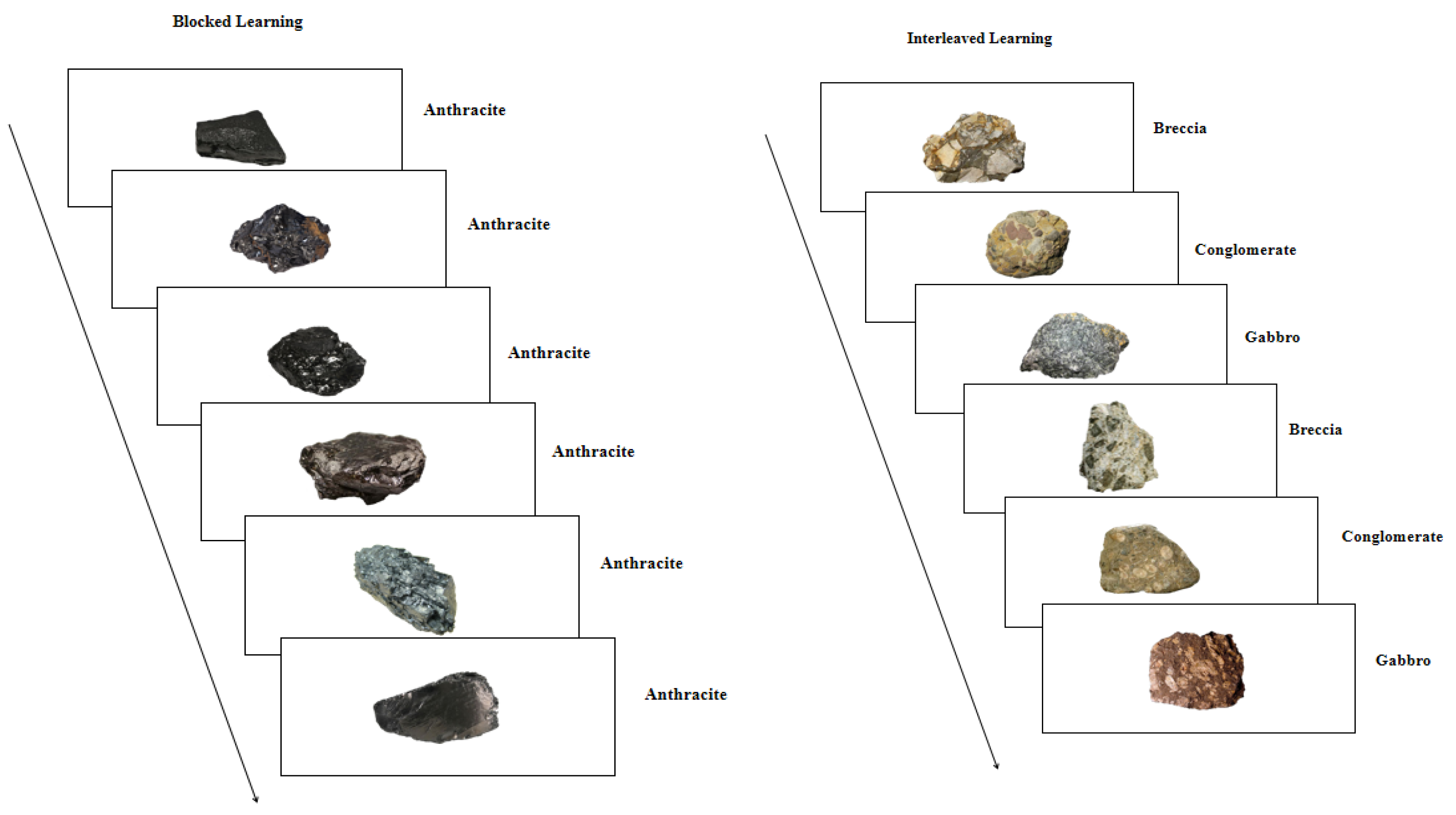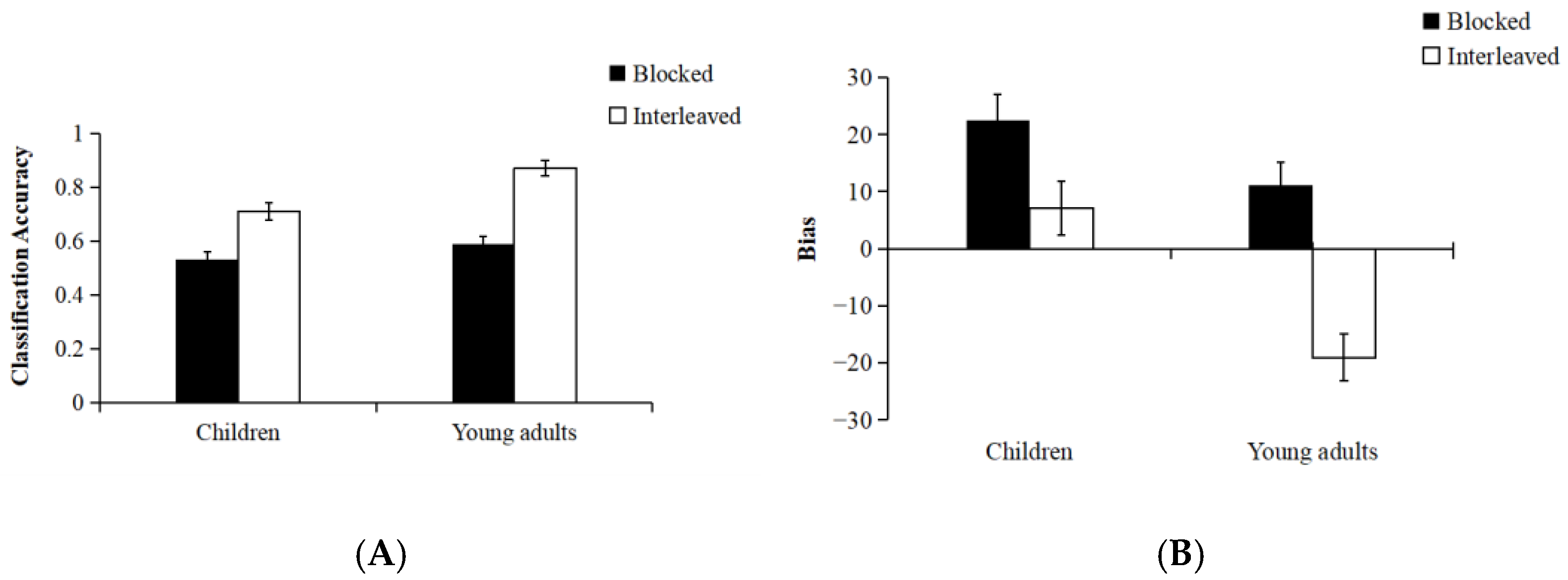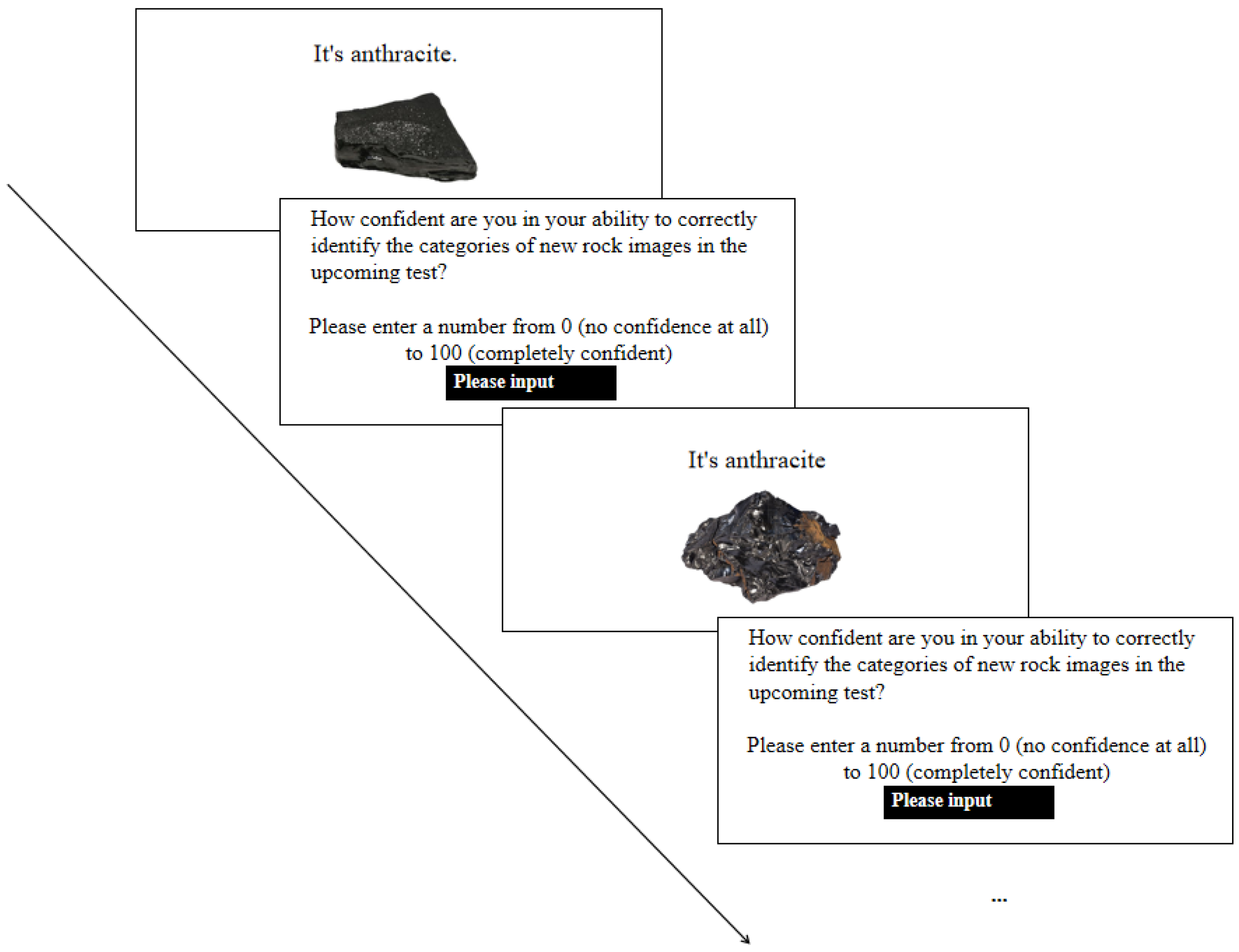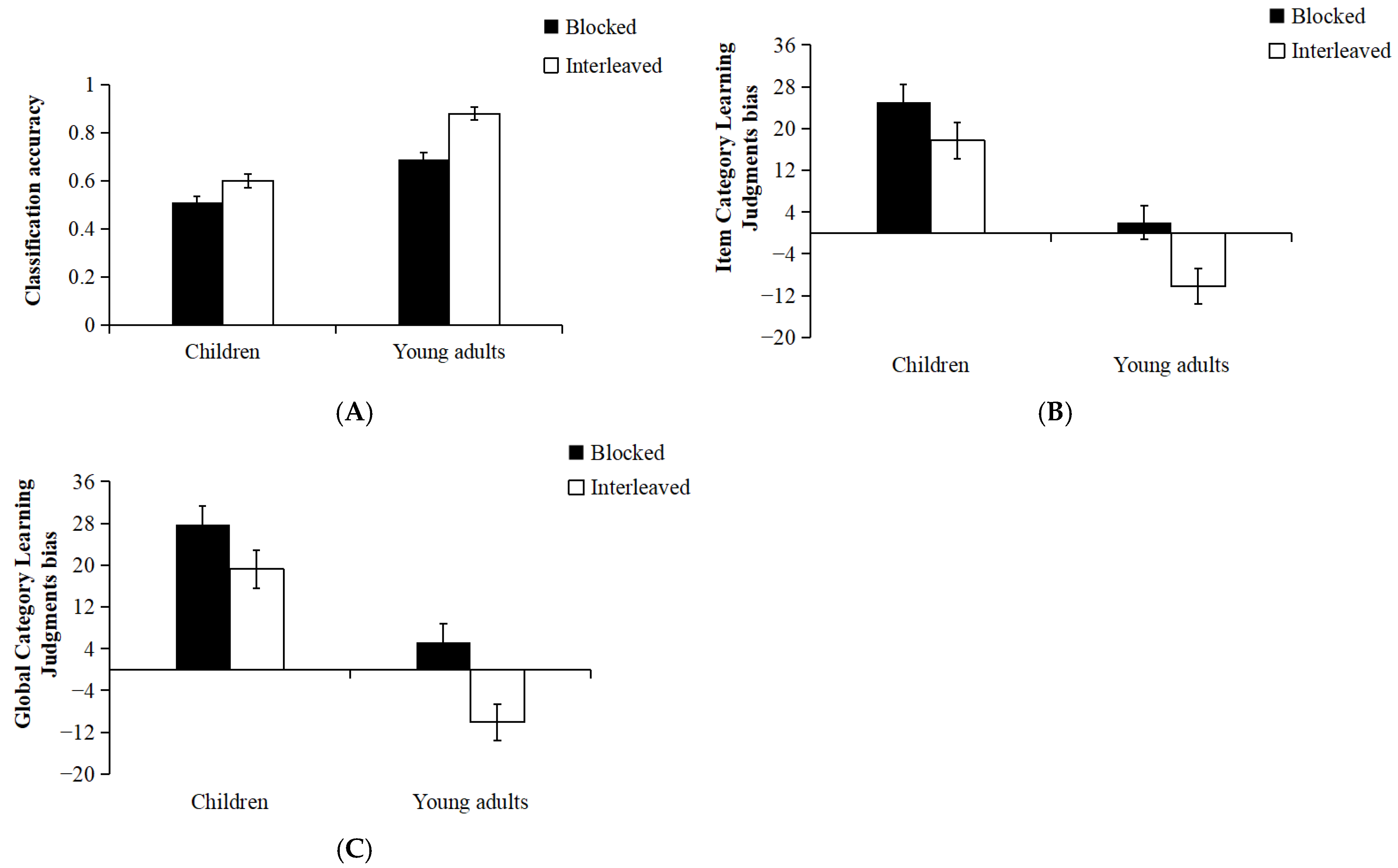Learning Natural Categories: Effects of Interleaving Practice in Children and Young Adults
Abstract
1. Introduction
1.1. The Mechanism of Interleaving Effect on Category Learning
1.2. The Effect of Interleaving on Category Learning Judgments
2. Overview of the Current Study
3. Experiment 1
3.1. Method
3.1.1. Participants
3.1.2. Design
3.1.3. Materials
3.1.4. Procedure
3.2. Results and Discussion
4. Experiment 2
4.1. Method
4.1.1. Participants and Design
4.1.2. Materials and Procedure
4.2. Results and Discussion
5. General Discussion
5.1. The Impact of Exemplar Sequence on Natural Category Categorization in Children and Young Adults
5.2. The Effect of Exemplar Sequence and Age Group on Category Learning Judgments
6. Limitations and Suggestions for Future Research
7. Practical Implications for Education
8. Conclusions
Author Contributions
Funding
Institutional Review Board Statement
Informed Consent Statement
Data Availability Statement
Conflicts of Interest
References
- Abel, Roman, Anique de Bruin, Erdem Onan, and Julian Roelle. 2024. Why do learners (under) utilize interleaving in learning confusable categories? The role of metastrategic knowledge and utility value of distinguishing. Educational Psychology Review 36: 64. [Google Scholar] [CrossRef]
- Babineau, Addison L., Amber E. Witherby, Robert Ariel, Michael A. Pelch, and Sarah K. Tauber. 2022. Do domain knowledge and retrieval practice predict students’ study order decisions? Journal of Intelligence 10: 122. [Google Scholar] [CrossRef] [PubMed]
- Birnbaum, Monica S, Nate Kornell, Elizabeth Ligon Bjork, and Robert A. Bjork. 2013. Why interleaving enhances inductive learning: The roles of discrimination and retrieval. Memory & Cognition 41: 392–402. [Google Scholar]
- Brunmair, Matthias, and Tobias Richter. 2019. Similarity matters: A meta-analysis of interleaved learning and its moderators. Psychological Bulletin 145: 1029–52. [Google Scholar] [CrossRef]
- Carvalho, Paulo F., and Robert L. Goldstone. 2014. Putting category learning in order: Category structure and temporal arrangement affect the benefit of interleaved over blocked study. Memory & Cognition 42: 481–95. [Google Scholar] [CrossRef]
- Chen, Ouhao, Fred Paas, and John Sweller. 2021. Spacing and interleaving effects require distinct theoretical bases: A systematic review testing the cognitive load and discriminative-contrast hypotheses. Educational Psychology Review 33: 1499–522. [Google Scholar] [CrossRef]
- Deng, Wei (Sophia), and Vladimir M. Sloutsky. 2016. Selective attention, diffused attention, and the development of categorization. Cognitive Psychology 91: 24–62. [Google Scholar] [CrossRef]
- Do, Lan Anh Do, and Ayanna K. Thomas. 2023. The underappreciated benefits of interleaving for category learning. Journal of Intelligence 11: 153. [Google Scholar] [CrossRef]
- Dong, Xiaoxiao, Yan Liu, and Huijing Lu. 2022. Effects of learning item difficulty and value on cognitive offloading during middle childhood. Metacognition and Learning 17: 1097–115. [Google Scholar] [CrossRef]
- Dunlosky, John, and Robert Ariel. 2011. Self-regulated learning and the allocation of study time. In Psychology of Learning and Motivation. San Diego: Academic Press, vol. 54, pp. 103–40. [Google Scholar]
- Finn, Bridgid, and Janet Metcalfe. 2014. Overconfidence in children’s multi-trial judgments of learning. Learning and Instruction 32: 1–9. [Google Scholar] [CrossRef]
- Foster, Nathaniel L., Michael L. Mueller, Christopher Was, Katherine A. Rawson, and John Dunlosky. 2019. Why does interleaving improve math learning? The contributions of discriminative contrast and distributed practice. Memory & Cognition 47: 1088–101. [Google Scholar] [CrossRef]
- Frank, Sebastian M., Susanne Bründl, Ulrike I. Frank, Yuka Sasaki, Mark W. Greenlee, and Takeo Watanabe. 2021. Fundamental differences in visual perceptual learning between children and adults. Current Biology 31: 427–32. [Google Scholar] [CrossRef] [PubMed]
- Hacker, Douglas J., Linda Bol, and Linda Keener. 2008. Metacognition in education: A focus on calibration. In Handbook of Metamemory and Memory. London: Psychology Press, pp. 429–55. [Google Scholar]
- Hartwig, M. K., and J. Dunlosky. 2017. Category learning judgments in the classroom: Can students judge how well they know course topics? Contemporary Educational Psychology 49: 80–90. [Google Scholar] [CrossRef]
- Janssen, Eva M., Tamara van Gog, Laura van de Groep, Anne Jóia de Lange, Roosmarijn L. Knopper, Erdem Onan, Wisnu Wiradhany, and Anique B. H. de Bruin. 2023. The role of mental effort in students’ perceptions of the effectiveness of interleaved and blocked study strategies and their willingness to use them. Educational Psychology Review 35: 85. [Google Scholar] [CrossRef]
- Kang, Sean H. K., and Harold Pashler. 2012. Learning painting styles: Spacing is advantageous when it promotes discriminative contrast. Applied Cognitive Psychology 26: 97–103. [Google Scholar] [CrossRef]
- Kirk-Johnson, Afton, Brian M. Galla, and Scott H. Fraundorf. 2019. Perceiving effort as poor learning: The misinterpreted-effort hypothesis of how experienced effort and perceived learning relate to study strategy choice. Cognitive Psychology 115: 101237. [Google Scholar] [CrossRef]
- Koriat, Asher. 1997. Monitoring one’s own knowledge during study: A cue-utilization approach to judgments of learning. Journal of Experimental Psychology: General 126: 349–70. [Google Scholar] [CrossRef]
- Koriat, Asher, Hilit Ma’ayan, and Ravit Nussinson. 2006. The intricate relationships between monitoring and control in metacognition: Lessons for the cause-and-effect relation between subjective experience and behavior. Journal of Experimental Psychology: General 135: 36–39. [Google Scholar] [CrossRef]
- Koriat, Asher, Rakefet Ackerman, Shiri Adiv, Kathrin Lockl, and Wolfgang Schneider. 2014. The effects of goal-driven and data-driven regulation on metacognitive monitoring during learning: A developmental perspective. Journal of Experimental Psychology: General 143: 386–403. [Google Scholar] [CrossRef]
- Kornell, Nate, and Robert A. Bjork. 2008. Learning concepts and categories: Is spacing the “enemy of induction”? Psychological Science 19: 585–92. [Google Scholar] [CrossRef]
- Lipko, Amanda R., John Dunlosky, Stacy L. Lipowski, and William E. Merriman. 2012. Young children are not underconfident with practice: The benefit of ignoring a fallible memory heuristic. Journal of Cognition and Development 13: 174–88. [Google Scholar] [CrossRef]
- Lipko-Speed, Amanda R. 2013. Can young children be more accurate predictors of their recall performance? Journal of Experimental Child Psychology 114: 357–63. [Google Scholar] [CrossRef]
- Meagher, Brian J., Mark A. McDaniel, and Robert M. Nosofsky. 2022. Effects of feature highlighting and causal explanations on category learning in a natural-science domain. Journal of Experimental Psychology: Applied 28: 283–313. [Google Scholar] [CrossRef] [PubMed]
- Morea, Aida, and Esther Calvete. 2021. Cognitive flexibility and selective attention’s associations with internalizing symptoms in adolescents: Are they reciprocal? Journal of Youth and Adolescence 50: 921–34. [Google Scholar] [CrossRef] [PubMed]
- Nemeth, Lea, Katharina Werker, Julia Arend, and Frank Lipowsky. 2021. Fostering the acquisition of subtraction strategies with interleaved practice: An intervention study with German third graders. Learning and Instruction 71: 101354. [Google Scholar] [CrossRef]
- Nosofsky, Robert M., Craig A. Sanders, and Mark A. McDaniel. 2018. Tests of an exemplar-memory model of classification learning in a high-dimensional natural-science category domain. Journal of Experimental Psychology: General 147: 328–53. [Google Scholar] [CrossRef]
- O’Leary, Allison P, and Vladimir M Sloutsky. 2019. Components of metacognition can function independently across development. Developmental Psychology 55: 315–28. [Google Scholar] [CrossRef]
- Pan, Steven C., Liwen Yu, Yilin Hong, Marcus J. Wong, Ganeash Selvarajan, and Michelle E. Kaku. 2025. Individual differences in fluid intelligence moderate the interleaving effect for perceptual category learning. Learning and Individual Differences 117: 102603. [Google Scholar] [CrossRef]
- Park, Jimin, Keisha Varma, and Sashank Varma. 2023. The role of executive function abilities in interleaved vs. blocked learning of science concepts. Frontiers in Psychology 14: 1199682. [Google Scholar] [CrossRef]
- Pillow, Bradford H., and RaeAnne M. Pearson. 2015. Children’s and adults’ judgments of the controllability of cognitive activities. Metacognition and Learning 10: 231–44. [Google Scholar] [CrossRef]
- Roebers, Claudia M. 2002. Confidence judgments in children’s and adults’ event recall and suggestibility. Developmental Psychology 38: 1052–67. [Google Scholar] [CrossRef]
- Roebers, Claudia M. 2014. Children’s deliberate memory development: The contribution of strategies and metacognitive processes. In The Wiley Handbook on the Development of Children’s Memory. Edited by Patricia J. Bauer and Robyn Fivush. Chichester: Wiley-Blackwell, vols. 1–2, pp. 865–94. [Google Scholar]
- Rohrer, Doug, Robert F. Dedrick, and Marissa K. Hartwig. 2020. The scarcity of interleaved practice in mathematics textbooks. Educational Psychology Review 32: 873–83. [Google Scholar] [CrossRef]
- Schneider, Wolfgang. 2015. Memory Development from Early Childhood Through Emerging Adulthood. New York: Springer. [Google Scholar]
- Schneider, Wolfgang, and Kathrin Lockl. 2008. Procedural metacognition in children: Evidence for developmental trends. In Handbook of Metamemory and Memory. Edited by John Dunlosky. Mahwah: Lawrence Erlbaum, vol. 14, pp. 391–409. [Google Scholar]
- Schwab, Jessica F., and Casey Lew-Williams. 2016. Repetition across successive sentences facilitates young children’s word learning. Developmental Psychology 52: 879–86. [Google Scholar] [CrossRef] [PubMed]
- Souchay, Céline, and Michel Isingrini. 2004. Age related differences in metacognitive control: Role of executive functioning. Brain and Cognition 56: 89–99. [Google Scholar] [CrossRef] [PubMed]
- van Loon, Mariëtte, Anique de Bruin, Jimmie Leppink, and Claudia Roebers. 2017. Why are children overconfident? Developmental differences in the implementation of accessibility cues when judging concept learning. Journal of Experimental Child Psychology 158: 77–94. [Google Scholar] [CrossRef]
- Vlach, Haley A., and Catherine A. DeBrock. 2017. Remember dax? Relations between children’s cross-situational word learning, memory, and language abilities. Journal of Memory and Language 93: 217–30. [Google Scholar] [CrossRef]
- Vlach, Haley A., and Chuck W. Kalish. 2014. Temporal dynamics of categorization: Forgetting as the basis of abstraction and generalization. Frontiers in Psychology 5: 1021. [Google Scholar] [CrossRef]
- Vlach, Haley A, and Scott P. Johnson. 2013. Memory constraints on infants’ cross-situational statistical learning. Cognition 127: 375–82. [Google Scholar] [CrossRef]
- Wahlheim, Christopher N., John Dunlosky, and Larry L. Jacoby. 2011. Spacing enhances the learning of natural concepts: An investigation of mechanisms, metacognition, and aging. Memory & Cognition 39: 750–63. [Google Scholar] [CrossRef]
- Yan, Veronica X., and Brendan A. Schuetze. 2022. Not just stimuli structure: Sequencing effects in category learning vary by task demands. Journal of Applied Research in Memory and Cognition 11: 218–28. [Google Scholar] [CrossRef]
- Yan, Veronica X., and Faria Sana. 2021. The Robustness of the interleaving benefit. Journal of Applied Research in Memory and Cognition 10: 589–602. [Google Scholar] [CrossRef]
- Zulkiply, Norehan, and Jennifer S. Burt. 2013. The exemplar interleaving effect in inductive learning: Moderation by the difficulty of category discriminations. Memory & Cognition 41: 16–27. [Google Scholar] [CrossRef]




| Children | Young Adults | |||
|---|---|---|---|---|
| Interleaved | Blocked | Interleaved | Blocked | |
| Mean Classification accuracy | 0.70 (0.17) | 0.53 (0.14) | 0.87 (0.11) | 0.59 (0.17) |
| Mean category learning judgments magnitude | 78.46 (17.21) | 75.00 (22.59) | 68.38 (14.35) | 70.31 (16.82) |
| Mean bias of category learning judgments | 7.94 | 22.18 ** | −19.05 ** | 11.08 * |
| Children | Young Adults | |||
|---|---|---|---|---|
| Interleaved | Blocked | Interleaved | Blocked | |
| Classification accuracy | 0.60 (0.23) | 0.51 (0.17) | 0.88 (0.10) | 0.69 (0.15) |
| Item category learning judgments magnitude | 77.35 (11.22) | 76.51 (12.92) | 77.41 (13.96) | 70.90 (14.77) |
| Global category learning judgments magnitude | 79.92 (15.43) | 79.68 (14.43) | 77.62 (14.41) | 74.13 (16.08) |
| Item category learning judgments bias | 17.17 ** | 25.14 ** | −10.28 ** | 2.01 |
| Global category learning judgments bias | 19.20 ** | 27.78 ** | −10.07 ** | 5.23 |
Disclaimer/Publisher’s Note: The statements, opinions and data contained in all publications are solely those of the individual author(s) and contributor(s) and not of MDPI and/or the editor(s). MDPI and/or the editor(s) disclaim responsibility for any injury to people or property resulting from any ideas, methods, instructions or products referred to in the content. |
© 2025 by the authors. Licensee MDPI, Basel, Switzerland. This article is an open access article distributed under the terms and conditions of the Creative Commons Attribution (CC BY) license (https://creativecommons.org/licenses/by/4.0/).
Share and Cite
Dong, X.; He, X.; Fang, L.; Xing, Q.; Ren, R. Learning Natural Categories: Effects of Interleaving Practice in Children and Young Adults. J. Intell. 2025, 13, 107. https://doi.org/10.3390/jintelligence13090107
Dong X, He X, Fang L, Xing Q, Ren R. Learning Natural Categories: Effects of Interleaving Practice in Children and Young Adults. Journal of Intelligence. 2025; 13(9):107. https://doi.org/10.3390/jintelligence13090107
Chicago/Turabian StyleDong, Xiaoxiao, Xiaoxiao He, Lingyu Fang, Qiang Xing, and Rongxia Ren. 2025. "Learning Natural Categories: Effects of Interleaving Practice in Children and Young Adults" Journal of Intelligence 13, no. 9: 107. https://doi.org/10.3390/jintelligence13090107
APA StyleDong, X., He, X., Fang, L., Xing, Q., & Ren, R. (2025). Learning Natural Categories: Effects of Interleaving Practice in Children and Young Adults. Journal of Intelligence, 13(9), 107. https://doi.org/10.3390/jintelligence13090107




